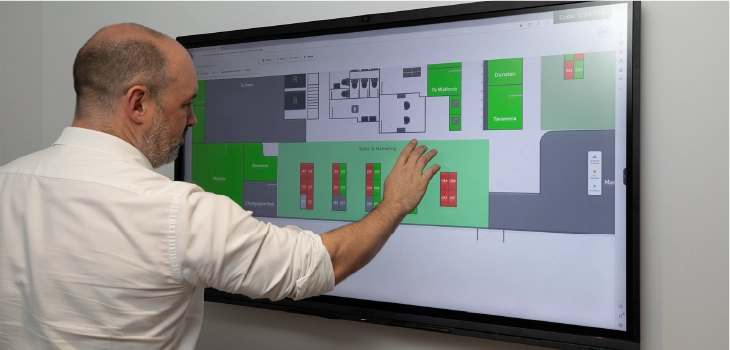Hybrid working has been around for years in various formats but the acceleration through the pandemic has not only changed the way we deliver hybrid work but also redefined the benefits that it can provide to businesses.
By: Brett Clark - General Manager Hybrid Workplace
In the UK I found the pre-pandemic focus had been on reducing real-estate footprint. Hybrid working, mainly utilising hot-desking, offered a way to reduce the number of seats needed in your building and therefore provided the ability to reduce office space or the opportunity to grow your headcount with a lower investment in real estate.
Beyond rent and utilities, operating an office space involves significant costs, including IT equipment, supplies, cleaning services, and security. By reducing the physical footprint through hybrid working, these expenses can be also significantly minimised.
But as Hybrid working took a deeper hold we saw a surge of other benefits come to the fore. Sustainability, for example, improved through better remote communications, reduced commuting, and a reduction in paper use, leading to businesses being able to meet their ESG goals more effectively.
But one of the most significant improvements was a lift in productivity for those businesses that successfully implement hybrid working.
Recent research conducted on behalf of Ricoh Europe has shown that providing hybrid working opportunities to your staff can deliver a 4% increase in productivity.
The latest workplace research, conducted by Opinium and analysed by CEBR on behalf of Ricoh Europe, polled 6,000 workers and 1,500 decision-makers across the continent. Business leaders say that workers are, on average, 4% more productive in a hybrid setting.
There are 4 key areas we’ve uncovered that contribute to this:
1. Promoting time to Focus
Hybrid working can significantly enhance employees’ opportunities to focus. Remote work eliminates office distractions and interruptions, enabling individuals to concentrate on their tasks. Employees can optimize their work environment by choosing the most conducive space for their productivity. On the other hand, office-based collaboration fosters synergy, creativity, and real-time problem-solving. Business leaders who embrace hybrid working encourage employees to strike the right balance, ensuring that they have the necessary tools, technology, and support to excel in both settings.
2. Fostering Employee Well-being
Employee well-being is paramount to maintaining a healthy and productive workforce. Hybrid working allows individuals to tailor their work environment to their specific needs. Remote work eliminates long commutes, reduces exposure to workplace stressors, and minimizes distractions, leading to improved mental health and overall well-being. Leaders can support employee well-being by promoting work-life integration, offering wellness resources, and prioritizing a healthy work culture that prioritizes self-care.
3. Empowering Autonomy and Ownership
Hybrid working cultivates a sense of autonomy and ownership among employees. Working remotely encourages individuals to take ownership of their tasks, deadlines, and deliverables. With increased freedom to choose their work environment, employees can create personalized setups that promote focus, creativity, and comfort. Leaders who embrace hybrid working empower their teams to make decisions and manage their workload independently, fostering a sense of trust, accountability, and empowerment.
4. Enhancing Work-Life Balance:
Employees have the flexibility to structure their work hours around personal commitments, reducing stress and burnout. By allowing individuals to manage their time effectively, C-suite leaders enable employees to engage in activities outside of work, such as family responsibilities, personal interests, and self-care. As a result, employees feel more fulfilled, rejuvenated, and motivated, leading to increased productivity and reduced absenteeism.
Implementing Hybrid
While the perception of hybrid working can be challenging for traditional business leaders who often see a less-occupied office, the results are hard to ignore. Not only can you expect an uplift in productivity but it has also become a prerequisite in hiring and retaining talent in NZ. It can help you achieve or improve your sustainability goals and improve the ability to report on them. It’s also an opportunity to rethink real estate requirements to cater to a more disrupted workforce and reduce the need for a large building footprint in high-cost areas like the CBD.
But Hybrid working needs a strategy. Thought leadership is needed around the mental well-being of your staff and how the changes could affect the way they have previously worked and performed. Employees need to be given the right spaces for them to be able to work effectively. Whether that’s deep at work in the quiet of a home office or spending the day in a ‘Destination Workplace’ where the office has been designed around collaboration, not daily routines.
Implementing the right tools, processes, and technology to deliver a seamless collaboration experience wherever your teams are will ensure you are able to reap the benefits and have a happier, more productive workforce.
Take the next step to find out more about Hybrid Work with Ricoh, or watch our case study on how Chorus implemented a Hybrid Working strategy in their new building.

Brett Clark
Brett is the GM of our Hybrid Workplace division and is driven to provide a better workplace experience for all New Zealanders.
Recommended resources for you

Making Work a Destination: Empowering Teams with Smarter Workspaces
RICOH Spaces transforms how teams work, integrating desk booking, meeting rooms, visitor management & IoT insights into one hybrid workplace solution.

Redefining the Destination Workplace: Why the C-Suite Must Lead the Hybrid Revolution
Discover how Ricoh Spaces helps leaders optimise space, enhance employee experience, and deliver measurable ESG impact.

Powering Workplace Collaboration: Bringing Modern Teams Rooms to Aotearoa
Upgrade Kiwi offices with Ricoh and Poly Teams Rooms; intuitive, inclusive hybrid meeting spaces powered by AI and backed by local NZ support.


